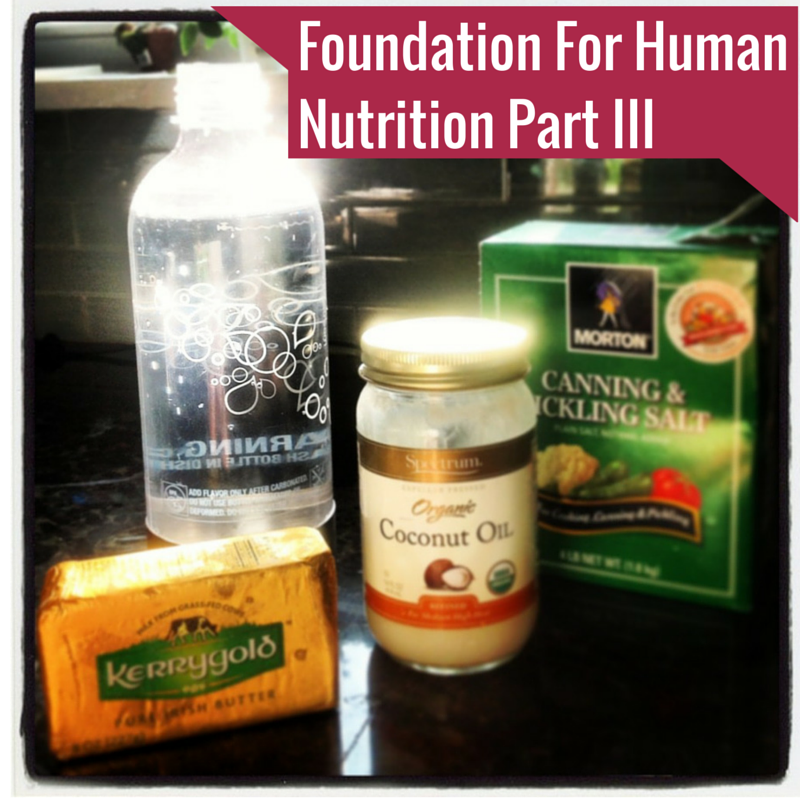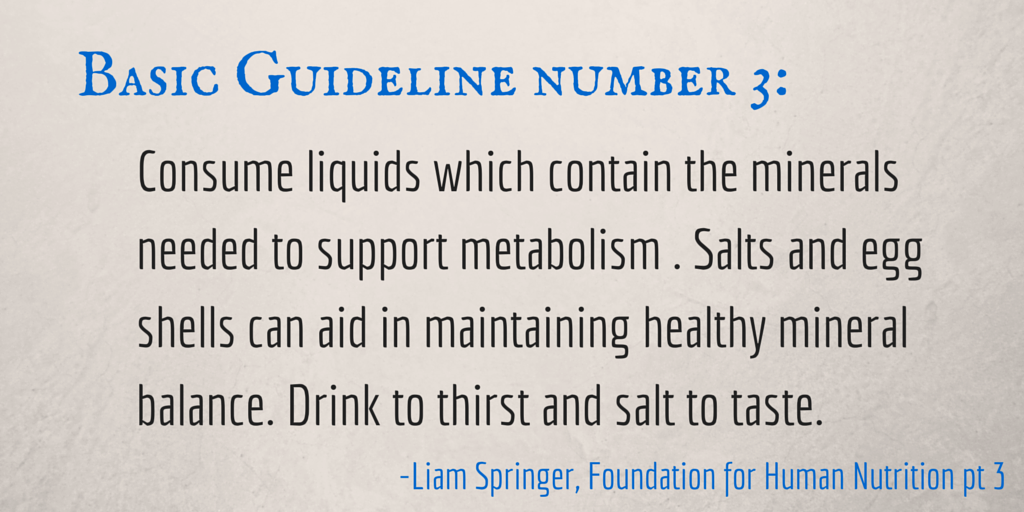
We have covered the major components of a healthy human diet in the previous post. The whole animal and plant foods in your diet will contain the necessary carbohydrates, proteins, fats, vitamins. These foods will also contain the majority of the necessary minerals and water. Fresh Water and dry minerals have always been coveted by human populations and in most cases are quite beneficial. We use water to aid in hydration and to process and cook foods. Minerals in the form of salts are used to preserve and flavor foods. As humans we have also used edible oils as a supplemental fat in the processing and cooking of foods. The effect of these supplemental foods on our health is an important consideration.

Hydration is a factor to keep in careful equilibrium. There is a common belief that the more water you drink the better. This is far from the case. It is important that the amount of water consumed does not exceed our ability to use the water effectively, or it can dilute and deplete our minerals. The importance of minerals has been briefly discussed in the blog on metabolism. The higher your metabolic rate relative to energy demands, the more able you are to retain minerals. It is also the case that the higher your metabolic rate, the more water you lose through the process of respiration. So in the case of individuals with elevated metabolic rates, quite a bit of energy and water may be needed relative to their need for minerals. Conversely the lower the metabolic rate, the more minerals are easily lost and the less water is lost through respiration. So for individuals with a sluggish metabolism, it will be extremely important to keep the mineral ratio high with respect to water and energy intake. For this reason it is a safe general rule to make sure that most of your hydration comes from nutrient rich sources high in minerals. Drinking too much pure water can dilute the content of electrolytes found in the body and adversely affect the metabolism. Tropical fruit juices, coconut water, stocks and broths made from the bones of animals, mineral waters, milk, coffee and tea can all be beneficial sources of hydration. Mineral water should be used only as needed to prevent dehydration. Many mineral waters are carbonated. CO2 is important in the retention of minerals in the cells, and our tissues and proteins will attach to CO2 when needed, so a sparkling mineral water can actually increase the health benefit. During dry periods of the year at high altitudes, or during periods of increased activity, the need for water may increase. For individuals with hyper metabolic states, pure water can be tolerated and even necessary, as they will lose many liters of water through respiration alone.
Dry minerals in the form of salts have been used in the human diet for many thousands of years. They have been used to preserve foods and are used often as a condiment to improve the flavor of our food. The primary mineral contained in these salts is sodium, which is very important to metabolism. It can aid in the use of blood sugar and thus reduce the need for hormone regulation such as insulin and adrenaline. It also helps to regulate the placement of water in the body. It can aid in pulling water out of the tissues and back into the blood through its interaction with albumin. It can also be ingested when there is an increased need for alkalizing minerals in order to spare the release of calcium, magnesium, and potassium from the bones and other tissues where they are needed for appropriate function. Finally sodium can interrupt inflammation as an antihistamine. This can help to reduce the reaction to common allergens. Another beneficial dietary mineral is calcium. The form of calcium and its relative ratio to phosphate is important when considering the food source. The only optimal food source that provides calcium in significant quantities is milk. However, a supplement made from the shells of eggs is also very easily absorbed and used by humans. Essentially you want to boil, dry and then grind the eggs into a fine powder (I will provide a link to the recipe in the resource section). Calcium boosts the metabolism, protects against bone loss, and decreases inflammation by interrupting the release of the parathyroid hormone. It is possible to overload on calcium, especially when using supplements which concentrate the calcium content of a natural diet. Roughly 1200 mg. is a generally recommended amount for most adults. However the “right” amount is not well understood and it will vary from person to person. It can even vary depending on the time of year or depending on recent activities an individual has engaged in. In general, a calcium rich diet is beneficial and diet induced calcium toxicity is extremely rare. In cases where increased calcium intake has been determined as an appropriate aid, up to 3000 mg. can be used for limited periods of time. In order to acquire 1200 mg. from milk alone, it would take one quart, from cheese about 5oz, and from the egg shells only about 1 and a half teaspoons. Other sources of calcium in a natural diet, such as sea food and bone broth, can also play an important role in the total calcium intake. The use of eggshells is only recommended in special cases and often only for limited periods of time. I often consume between 32-64oz of milk in a day in addition to eating cheese and drinking broth. There is definitely no need for me to supplement my calcium intake with eggshells. It is not a concern how much calcium one gets from these food sources and it will not become toxic at a quantity that is realistically consumable.
Both water and mineral intake need to be coordinated. The necessary amounts are going to be different for different people. It will even change for the same individual depending on many internal and external environmental factors. The best place to start is with the right foods and liquids, and only drinking for thirst and salting food for taste. Intentional supplementation of minerals or water should be well considered and carried out with a programmed intention and routine assessment of the benefit.
Basic Guideline number 4: When adding fat to the diet, use predominantly butter or coconut oil, and use olive oil or macadamia nut oil sparingly for dressings and taste.
Healthy fats play an important role in the human diet. Fat is an incredibly complex subject, but for the matter of this blog, I will say that fat has a tremendous influence on human physiology, and dietary fats should be carefully regarded. We more thoroughly enjoy our meals when fat is a component. Many vitamins are brought into the body by fat, and fat supplements energy needs in order to aid the efficiency of carbohydrate metabolism. There are some whole animal foods which should be providing much of the needed nutritious fats. Eggs contain very nutrient dense fats in the yolk, but they must be from very well cared for hens in order to reduce the content of oxidative fatty acids. Liver, while low in fat, is high in fat soluble vitamins, and the white marrow of animals is also a very nutrient rich source of fat. We also use edible oils which are derived from animals and plants. The obvious leader in nutrient quality is the butter fat contained in all dairy products. It is relatively high in vitamin E in proportion to the highly oxidative fats, and contains a variety of short chain fatty acids with beneficial actions for the metabolism. It also contains high levels of vitamin A and D. Tallow is the fat rendered from beef and Lard from pork. If the animals are well cared for and their diet is healthy, the fat can be nutritious and it is a way to use the whole animal and reduce waste. Lard has more recently been higher in toxic fats due to the common feeding practices and so would be best avoided. Coconut oil is also an excellent source of energy, as it is unusually rich in the medium chain fatty acids. These fatty acids can be used by the cells for energy production directly after absorption through the intestine rather than having to first be processed by the liver and/or fat cells. This helps with boosting the metabolism, weight loss, and reducing cellular stress. Coconut oil aids many whom are healing a dysfunctional carbohydrate metabolism. Olive oil is a great-tasting oil for low heat cooking and dressings and has beneficial properties. Macadamia nut oil, which is particularly non-toxic as far as nuts go due to its growing in a tropical climate, is similar to olive oil in its benefit. Although they do contain higher levels of toxic fats than butter or coconut oil, they also contain enough vitamin E to aid in the regulation of the toxic effects. Other oils that are safe for consumption are palm kernel oil, and palm fruit oil.
The first 4 of my 5 basic guidelines outline what to eat in a very general way. I will continue to provide more information on which foods specifically offer the greatest benefit and how they can best be used. However, I feel it is important to start with general guidelines so people can explore and find the foods that work well for themselves. The idea is not to feel confined to a handful of foods. Having covered the foods to include brings us to the final guideline, which will outline the foods that are detrimental and should be limited in their consumption. In my next post I will take time to outline how these foods interrupt the optimal function of the body so you can use them considerately. It is important to not feel like you aren’t allowed to eat something or like a food is bad. Instead, you must learn to discern which foods are worthwhile.
Hydration and disease
http://www.jacn.org/content/26/suppl_5/535S.full
Water needs calculated by various environmental factors and metabolic activity:
http://www.ncbi.nlm.nih.gov/pubmed/22714078
Gilbert Lings AI theory of cellular function: Explains the relative individual need and overal imprtance of minerals in metabolic process.
Co2increased resistance to acute hypoxia
http://www.ncbi.nlm.nih.gov/pubmed/720676
CO2 bath increases Blood content and nutrient delivery
http://www.ncbi.nlm.nih.gov/pubmed/11579696
ATP effects the osmotic regulation of the cell when bound to magnesium:
http://www.ncbi.nlm.nih.gov/pmc/articles/PMC1180194/
Magnesium and ATP and metabolism
http://www.dannyroddy.com/main/2013/13/3/is-supplemental-magnesium-a-surrogate-for-thyroid-hormone
Magnesium is lost during anaerobic metabolism requiring glycolitic energy production:
http://www.ncbi.nlm.nih.gov/pubmed/355821
Hypothyroid reduces sodium retention
http://www.ncbi.nlm.nih.gov/m/pubmed/11246114/
No health benifitial to significant salt restriction studies show potential detriment to those restricting
Sodium albumin vascular permiability
http://www.ncbi.nlm.nih.gov/pmc/articles/PMC2821727/
http://www.ncbi.nlm.nih.gov/pubmed/7952614
http://www.ncbi.nlm.nih.gov/pubmed/2988828
http://hyper.ahajournals.org/content/31/1/451.short
Sodium inflammation
http://www.ncbi.nlm.nih.gov/pubmed/3144402
Salt metabolism and fluid movement in sleep apnea:http://books.google.com/books?id=vcg8PbacMT8C&pg=PA129&lpg=PA129&dq=increased+salt+decreased+vascular+permeability&source=bl&ots=ZxUwwvIBTy&sig=hj7cXFTC0K-4LLyCds3zzI8zA5A&hl=en&sa=X&ei=UsU6UYa_OZLOyAGk1IHgDA&ved=0CFkQ6AEwBg#v=onepage&q=increased%20salt%20decreased%20vascular%20permeability&f=false
High salt diet increases insulin independent glucose uptake
http://www.ncbi.nlm.nih.gov/pubmed/9234825
Fibrosis cellular electrolyte balance
http://fibroself-help.com/causes
Calcium Parathyroid Hormone and Blood Preasure:
http://www.ncbi.nlm.nih.gov/pubmed/10818080
Calcium and weight loss:
http://www.ncbi.nlm.nih.gov/pubmed/11134120
Calcium activates uncoupling proteins and elevates core body temperature:
http://jn.nutrition.org/content/134/11/3054.full
Mitochondrial uncoupling proteins:
http://diabetes.diabetesjournals.org/content/53/suppl_1/S130.full
http://www.ncbi.nlm.nih.gov/pmc/articles/PMC1592539/
Calcium dependent processes including activation of uncoupling proteins protects against nerve death:
http://www.bioportfolio.com/resources/pmarticle/63089/Activation-Of-Calcium-calmodulin-dependent-Protein-Kinase-Iv-And-Peroxisome-Proliferator-activated.html
Egg shell calcium recipe and video:
Fat content of butter:
http://www.degruyter.com/view/j/pjfns.2011.61.issue-3/v10222-011-0020-x/v10222-011-0020-x.xml
Coconut oil better for weight loss than olive oil:
http://www.ncbi.nlm.nih.gov/pubmed/18326600
Coconut oil protects against bone loss:
http://www.ncbi.nlm.nih.gov/pmc/articles/PMC3457741/
Coconut oil increases mitachondrial resperation:
http://www.ncbi.nlm.nih.gov/pubmed/19720794
http://diabetes.diabetesjournals.org/content/58/11/2547.full?sid=091dd77e-0632-4f1c-bcbd-f0b1c42544ba
Study on ghee and health in Indians
http://www.ncbi.nlm.nih.gov/pmc/articles/PMC3215354/#!po=91.1458
Phytanic acid and its bio active properties it is not linked to prostate cancer in a causal manner: dairy is anti diabetic
http://www.academia.edu/420579/Phytanic_acid_-_An_overlooked_bioactive_fatty_acid_in_dairy_fat
Phytanic acid anti diabetic effect in humans
http://www.plosone.org/article/info:doi/10.1371/journal.pone.0045638
Dairy fat increases phytanic acid
http://academia.edu/894444/Effect_of_dairy_fat_on_plasma_phytanic_acid_in_healthy_volunteers_-_a_randomized_controlled_study
Phytanic acid activates uncoupling protein
http://www.researchgate.net/publication/11530415_Phytanic_acid_a_novel_activator_of_uncoupling_protein-1_gene_transcription_and_brown_adipocyte_differentiation








https://www.mamanatural.com/how-to-make-eggshell-calcium/
Could not get the address you recommend on this topic to pull up. Your site is a fortunate find and I just subscribed.
Try this